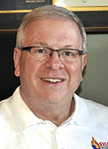
Keeping It Safe Robert Tutterow

I recently had the opportunity to attend a fire service technology summit in Irving, Texas. Wow! It was overwhelming to me and probably a few others.
Technological changes are emerging or will soon emerge in so many areas of the fire service. Of particular note was the premise by almost all of the presenters that the changes are for improved firefighter health and safety. As the presentations unfolded, I could easily see that there is a lot of health and safety benefit from using technology.
Without surprise, some of the highly touted technology products were drones. Many departments are using them, and it was interesting to learn about getting trained and licensed to fly a drone and how drones interact with the Federal Aviation Administration. For now, it appears that drones are used as an “eye in the sky” for U.S. departments. It is expected that the “eye in the sky” application will be enhanced soon. Drones will be automatically dispatched to an emergency at the same time the nearest station is dispatched. The drone will arrive ahead of responding personnel and provide a 360-degree view of the scene and immediately relay the information. The cameras on the drone will include infrared and 3D capabilities. All of this will aid in apparatus placement, size-up, and establishing the initial attack. For nonfire emergencies, the “eye in the sky” can be especially useful for auto accidents, hazmat incidents, and various special operations responses. One can only imagine other drone capabilities in addition to the “eye in the sky” application.
The wildland fire service can potentially see dramatic improvement in its capabilities to suppress fires. There are plans to have fires detected from outer space as soon as they start. Once detected, strategically placed drones will automatically head to the scene and suppress the fire while in the beginning stage.
Another wildland example of technology is the tactical command vehicle developed by Darley and Ford Motor Company. Built on a Bronco chassis, the data-driven design will have expanded communications technology to assist in remote areas.
From a personal protective equipment perspective, wearable technology is on the cusp of reality. Firefighters’ vital signs will be constantly monitored while on the scene. Those doing the monitoring can be located anywhere—on the scene, in a dispatch center, at a station, or perhaps in a home. The current thought is that the monitoring will be simplified by setting predetermined alerts if a firefighter is in trouble. There is wearable technology (Ease Alert) to awaken firefighters when they are asleep without sending a loud shock to the body. And, also on the cusp of reality, is finally a firefighter locator system that really works.
Though not specifically mentioned during the summit, what is the reluctance to go to computer screens—i.e., iPads—for pump panels? They can be enlarged, made robust, and operate remotely from the pump, allowing the pump operator to stand or sit anywhere around the pumping apparatus. And speaking of apparatus, navigating to an emergency will be much safer with the development of smart cities and the smart road network. Couple that with the motoring public being alerted to a responding emergency vehicle with HAAS Alert or something similar.
Artificial Intelligence (AI)—oh my. Where and how this will impact the fire service is beyond anything I can comprehend and describe. I will simply say that Microsoft was a prominent vendor at the summit, and it is all over AI.
Baked into all technology is data, and the world of fire-related data is about to explode. The U.S. Fire Administration is about to launch a new incident reporting system. And, the data from that system will finally be of use. I would be remiss if I did not mention the Firefighter Cancer Registry that is now underway. If you have not yet registered, do it without further delay. Almost all fire service research is data-driven. Without data, it is hard to get research funding. As the saying goes, “The side with the best data typically wins.”
We really need to embrace innovative technology. The new generation of firefighters expects it. I think it is an effective way to get them to buy into the fire service with a passion that seems to be waning based on the difficulty in getting and retaining members. Also, think about fire apparatus. If you are starting to specify a new apparatus, by the time you get the specs developed, complete the bid process, build the truck, and take delivery, you may be looking at up to a four-year process. Then, if you keep the apparatus in service for 15 years, you are using that apparatus in the year 2044. What will technology be then? How obsolete might the apparatus be? The same applies to a fire station. There is a world of recent technology available for fire stations, and their life expectancy is around 50 to 70 years. Getting out to the forefront is not a careless use of funds.
ROBERT TUTTEROW retired as safety coordinator for the Charlotte (NC) Fire Department and is a member of the Fire Apparatus & Emergency Equipment Editorial Advisory Board. His 44-year career includes 10 as a volunteer. He has been very active in the National Fire Protection Association through service on the Fire Service Section Executive Board and technical committees involved with safety, apparatus, and personal protective equipment. He is a founding member and president of the Fire Industry Education Resource Organization (F.I.E.R.O.).

